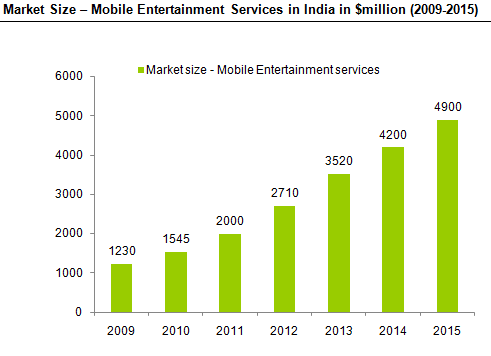 The mobile entertainment industry in India is witnessing significant growth and Tavess forecasts this market to reach $4.9 billion in 2015 from $1.2 billion in 2009, growing at a CAGR of 26% in the period 2009-2015.
The mobile entertainment industry in India is witnessing significant growth and Tavess forecasts this market to reach $4.9 billion in 2015 from $1.2 billion in 2009, growing at a CAGR of 26% in the period 2009-2015.
Tavess believes that mobile entertainment has a huge potential in India and the current localization of mobile entertainment content is driving the industry in the right direction, bringing in greater usability of content.
In the coming years mobile entertainment landscape will see several changes with respect to greater integration of mobile entertainment services with social networking, increased significance of user generated content, which will be a major focus area for telecom operators, and the growth of infotainment services.
Tavess also expects a rise in mobile advertising programs focused on providing credits to users for watching advertisements. Mobile music will, however, continue to dominate the mobile entertainment services landscape with significant growth potential presented by mobile video and TV.
Mobile music is the most demanded entertainment service by the Indian consumers with ring back tones and ring tones being the most popular, followed by single track music downloads. Mobile operators are placing great emphasis on music streaming services with players such as Vodafone, Reliance, and Idea offering music streaming at very affordable prices. For example, Vodafone offers subscription-based music streaming services for INR 50 per month ($1.09), which provides subscribers access to its music station with 40,000 songs, and 30 music channels in nine languages.
Similarly, handset manufacturers are taking several initiatives to tap the opportunity presented by the Indian digital music market. For example, Nokia has launched its music store under the brand Ovi for Nokia handset owners. Ovi is focusing on providing localized content to users and offers Indian users with a choice of 3.5 million tracks.
Gaming on mobile phones is also gaining traction with leading Indian gaming companies, such as Zapak, ibibo, and Indiagames, launching mobile based gaming platforms providing users access to multiple games while incorporating social networking functionalities with gaming. Gaming in India is gaining market owing to content localization, for example, t20fever.com launched by Indiagames, and ICC World Cup 2011 game launched by Zapak.
The mobile gaming market is also being cashed in by major handset providers that are launching sophisticated handsets with advanced functionalities for gaming. Tavess expects greater adoption of multi-player mobile games, along with 3D and mythological games, and social gaming that will continue to grow at a steady pace in the next 4-5 years.
With the launch of 3G services, the mobile TV and video landscape in India is also witnessing rapid changes. Tavess believes that India has good future potential for mobile video streaming services, especially for videos focused on cricket highlights and updates, in addition to film based content. However, as many subscribers are not accustomed to paid subscription-based services, the monetization of video content will be primarily through advertisements. Tavess also expects greater adoption of mobile TV with users preferring to watch television on mobile while being on the move.
While these initiatives set the platform for growth, it is important for all the players to continuously invest in launching new and innovative data services to keep the momentum up and gain competitive edge.The increased commoditization of voice services with rapidly declining voice tariffs is resulting in diminishing voice ARPU for Indian mobile operators.
To address this challenge and to earn additional revenues from existing customers, Indian mobile operators are increasing their focus on data services, primarily entertainment services such as mobile music, gaming and video/tv.
















